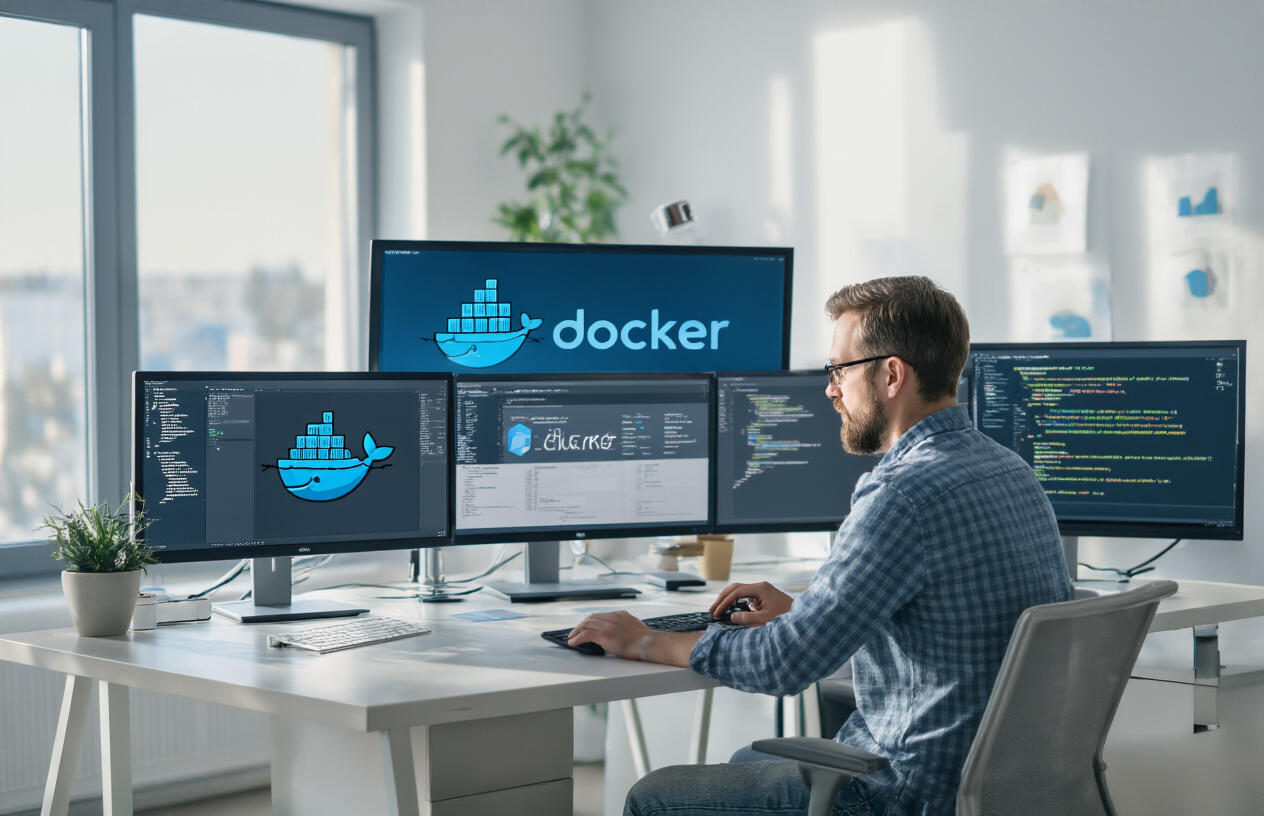AWS CDK deployments can take forever when you’re rebuilding containers from scratch every single time. For DevOps engineers, cloud architects, and development teams working with containerized AWS CDK applications, slow build times kill productivity and make CI/CD pipelines crawl.
Docker cache CDK optimization changes everything. Instead of waiting 10-15 minutes for each deployment, you can cut build times down to under 2 minutes by reusing existing Docker layers. This isn’t just about speed – it’s about creating CDK workflow efficiency that lets your team ship faster and iterate more.
We’ll walk through the Docker cache fundamentals that make AWS CDK performance actually work at scale. You’ll learn how to implement Docker layer caching CDK strategies that stick, even when your infrastructure changes. Then we’ll cover advanced cache optimization techniques that squeeze every second out of your CDK deployment speed, plus real ways to measure whether your Docker cache strategies are actually working.
Understanding AWS CDK Performance Bottlenecks
Identifying Common Build Time Inefficiencies
AWS CDK workflows often suffer from predictable performance bottlenecks that significantly impact development velocity. The most common culprit is redundant dependency installation during each build cycle, where Node.js packages, Python libraries, or Docker base images are downloaded repeatedly despite minimal code changes. Lambda function bundling represents another major inefficiency, as CDK rebuilds entire deployment packages even when only configuration parameters change. Asset compilation for frontend applications compounds these issues, forcing complete rebuilds of static resources that haven’t been modified. Many teams experience extended deployment times when CDK synthesizes CloudFormation templates unnecessarily, especially in projects with multiple stacks or complex cross-stack references.
Analyzing Docker Image Rebuild Overhead
Docker image rebuilds consume substantial resources in CDK workflows, particularly when containerized applications require frequent updates. Each rebuild typically involves downloading base images, installing system packages, copying application code, and running build scripts from scratch. The overhead becomes more pronounced with larger base images like Ubuntu or Amazon Linux, where package installations alone can consume several minutes per build. Multi-stage builds without proper layer optimization create additional inefficiencies, as intermediate artifacts get recreated unnecessarily. CDK constructs that generate Docker assets face compounding delays when multiple containers require rebuilds simultaneously, creating deployment bottlenecks that scale poorly with project complexity.
Measuring Current Workflow Performance Metrics
Establishing baseline performance metrics helps quantify CDK optimization improvements and identify the most impactful bottlenecks. Key metrics include total deployment time, Docker build duration, asset synthesis time, and CloudFormation stack update duration. AWS CloudWatch and CDK deployment logs provide visibility into individual operation timings, while Docker build logs reveal layer-specific performance data. Tracking cache hit rates across different build stages highlights which components benefit most from optimization efforts. Memory and CPU utilization during builds indicates resource constraints that might limit concurrent operations. Regular measurement of these metrics before and after optimization changes validates the effectiveness of Docker cache strategies and guides further performance tuning decisions.
Docker Cache Fundamentals for CDK Optimization
How Docker Layer Caching Works
Docker layer caching transforms AWS CDK performance by storing intermediate build steps as reusable layers. Each Dockerfile instruction creates a layer that gets cached when unchanged. When you rebuild your CDK application, Docker checks if source files or dependencies changed. If not, it skips rebuilding those layers entirely. This mechanism dramatically reduces build times for CDK workflows since most layers remain static between deployments. Understanding layer ordering becomes critical – place frequently changing code at the bottom of your Dockerfile to maximize cache hits and optimize your CDK deployment speed.
Cache Invalidation Triggers and Prevention
Cache invalidation happens when Docker detects changes in layer inputs, forcing expensive rebuilds of your CDK applications. Common triggers include modified source code, updated package.json files, changed environment variables, or altered base images. Smart developers prevent unnecessary invalidation by carefully structuring Dockerfiles. Copy dependency files before application code, use .dockerignore to exclude irrelevant files, and pin base image versions. Timestamp changes in copied files also trigger invalidation, so avoid copying entire directories when specific files suffice. These CDK optimization techniques keep your builds fast and predictable.
Multi-Stage Build Benefits for CDK Applications
Multi-stage builds revolutionize CDK container optimization by separating build dependencies from runtime requirements. Your first stage installs build tools, compiles TypeScript, and bundles assets. The final stage copies only production artifacts, creating smaller, more secure images. This approach dramatically reduces image size while maintaining full CDK functionality. Build caches persist across stages, so unchanged dependencies in early stages don’t rebuild unnecessarily. Multi-stage builds also enable parallel building of different components, further accelerating your AWS CDK workflow efficiency and reducing deployment times significantly.
Local vs Remote Cache Storage Options
Local Docker cache storage provides immediate performance gains for individual developers working on CDK projects. Your machine stores layers in Docker’s local cache, delivering fast rebuilds during development cycles. However, team environments benefit more from remote cache solutions like Amazon ECR or Docker Hub registry caches. Remote caching enables shared cache layers across team members and CI/CD pipelines, ensuring consistent AWS CDK performance regardless of build environment. Cloud-based cache storage scales automatically and integrates seamlessly with existing AWS infrastructure, making it ideal for production CDK deployment workflows.
Implementing Docker Cache Strategies in CDK Workflows
Optimizing Dockerfile Layer Order for Maximum Cache Hits
Structure your Dockerfile with static dependencies first, followed by frequently changing application code. Place COPY package.json and RUN npm install before copying source files, ensuring dependency layers remain cached when only code changes. This AWS CDK optimization approach dramatically reduces Docker layer caching CDK build times during development cycles.
Leveraging BuildKit Features for Enhanced Caching
Enable BuildKit’s advanced caching capabilities using DOCKER_BUILDKIT=1 environment variable. BuildKit provides parallel layer building, cache mount syntax, and improved cache invalidation logic. Configure cache backends with --cache-from and --cache-to flags to share layers across builds, boosting CDK deployment speed significantly compared to legacy Docker builds.
Configuring Cache Mount Points for Dependencies
Mount package manager caches directly into containers using BuildKit’s RUN --mount=type=cache syntax. Create persistent cache directories for npm (/root/.npm), pip (/root/.cache/pip), or Maven (/root/.m2) to avoid re-downloading dependencies. This CDK workflow efficiency technique reduces network overhead and speeds up subsequent builds by reusing cached packages.
Setting Up Shared Cache Volumes Across Team Members
Implement centralized cache storage using Docker registry cache layers or shared network volumes. Configure AWS ECR as a cache registry where team members can push and pull cached layers. Set up CI/CD pipelines to populate shared caches, ensuring consistent AWS CDK performance improvements across development environments and reducing individual developer build times.
Advanced Cache Optimization Techniques
Using Cache-from and Cache-to Arguments Effectively
Mastering --cache-from and --cache-to arguments transforms your AWS CDK Docker builds from sluggish workflows into lightning-fast deployments. The --cache-from argument pulls existing cache layers from remote registries, while --cache-to pushes your build cache to external storage like Amazon ECR or S3. Smart developers configure multiple cache sources using comma-separated values: --cache-from=type=registry,ref=myrepo:cache,type=local,src=/tmp/cache. This creates a fallback hierarchy where Docker checks local cache first, then remote registries. For CDK workflows, implement cache export strategies that target specific stages: --cache-to=type=registry,ref=myrepo:cache,mode=max exports all layers, while mode=min only caches the final image. Advanced practitioners use inline cache exports within Dockerfiles using RUN --mount=type=cache directives, creating persistent cache volumes that survive container rebuilds and dramatically reduce CDK deployment times.
Implementing Parallel Build Stages with Cached Dependencies
Parallel build stages with Docker layer caching CDK transforms monolithic builds into concurrent powerhouses that slash deployment times. Multi-stage Dockerfiles become your secret weapon – split dependency installation, application building, and runtime preparation into separate stages that build simultaneously. Configure your CDK stack with DockerImageAsset properties that enable parallel execution: set target parameters for different stages and leverage Docker’s --parallel flag. Smart caching strategies involve creating base images for common dependencies – Node.js modules, Python packages, or Java libraries – that rarely change. Your parallel stages can share these cached layers while building application-specific components independently. Cache mount points using RUN --mount=type=cache,target=/root/.npm persist package manager caches across builds, while dependency stages run concurrently with application compilation. This AWS CDK optimization technique reduces build times from minutes to seconds, especially for complex applications with heavy dependency trees.
Managing Cache Size and Cleanup Strategies
Cache bloat kills CDK workflow efficiency faster than any misconfiguration – implement aggressive cleanup strategies to maintain optimal Docker cache performance. Docker’s cache accumulates layers exponentially, with typical CDK projects generating gigabytes of cached data within weeks. Use docker system prune -f commands in your CI/CD pipelines, but go beyond basic cleanup with targeted strategies. Implement cache expiration policies using --filter until=72h to remove stale layers while preserving recent builds. For AWS CDK build optimization, configure cache limits with --storage-opt size=10GB in Docker daemon settings, preventing runaway cache growth that degrades performance. Smart developers use multi-level cleanup: immediate cleanup of intermediate containers, weekly pruning of unused images, and monthly deep cleaning of build caches. Remote cache management becomes critical – set retention policies on Amazon ECR repositories to automatically delete old cache layers. Monitor cache hit rates using Docker build output and CDK deployment metrics to balance storage costs with build speed improvements.
Measuring and Monitoring Cache Performance Improvements
Setting Up Build Time Metrics and Dashboards
Create comprehensive monitoring by tracking key CDK deployment metrics like build duration, Docker layer cache hit rates, and resource provisioning times. Set up CloudWatch dashboards to visualize cache performance trends, deployment frequency, and average build times. Implement custom metrics using CDK’s built-in logging capabilities to capture detailed timing data for each build phase. Configure alerts for cache miss spikes or unusual build duration increases to proactively identify AWS CDK performance issues.
Calculating ROI from Cache Implementation
Quantify your Docker cache CDK benefits by measuring time savings across development teams and deployment pipelines. Calculate cost reductions from decreased AWS CodeBuild minutes, reduced developer wait times, and improved deployment frequency. Track metrics like average build time reduction percentage, developer productivity gains, and infrastructure cost savings. A typical cache implementation delivers 40-60% build time improvements, translating to significant cost savings for teams running multiple daily deployments.
Troubleshooting Cache Miss Issues
Diagnose cache misses by analyzing Docker layer dependencies and CDK construct changes that invalidate cached layers. Common culprits include timestamp-based file modifications, environment variable changes, and dependency updates that break cache consistency. Use Docker build logs to identify which layers triggered cache invalidation and review your CDK workflow efficiency patterns. Implement proper .dockerignore files and stable base images to minimize unnecessary cache breaks while maintaining CDK deployment speed.
Establishing Cache Performance Benchmarks
Define baseline metrics for your CDK container optimization strategy by measuring initial build times without caching enabled. Establish target performance goals like sub-5-minute deployment times for typical infrastructure changes and sub-10-minute times for full stack deployments. Create performance regression tests that validate cache effectiveness after CDK updates or workflow changes. Document your CDK best practices and share benchmark results across teams to maintain consistent AWS CDK build optimization standards.
AWS CDK workflows can become much more efficient when you take advantage of Docker caching strategies. By understanding where performance bottlenecks happen and implementing smart caching techniques, you can dramatically reduce build times and improve your development experience. The key is setting up proper cache layers, using multi-stage builds effectively, and monitoring your improvements to make sure your optimizations are actually working.
Start implementing these Docker cache strategies in your next CDK project and watch your deployment times drop significantly. Track your build performance before and after making changes so you can see the real impact. Your team will appreciate faster feedback loops, and you’ll spend less time waiting for builds to complete and more time writing code that matters.




















